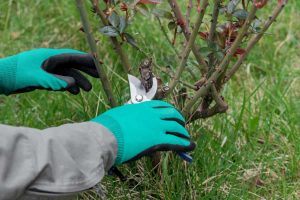Roses are often referred to as the “queen of the garden” and exude sophistication and beauty no matter what outdoor space they are used in. Giving your roses the right care and attention at the right time of year depending on the seasons is crucial if you want your roses to bloom and bloom beautifully all year round. With the guidelines in this book and by caring for roses properly in each of the four seasons, you can create a garden that your neighbors will talk about.
1. Spring: Preparing for Growth
Once winter is over and spring sets in, your roses will begin to come out of dormancy. It’s never too early to get a head start on their growth next season, and now is the ideal time to do so.
Pruning: Before you start pruning your roses, remove any diseased or dead trees from the roses. This stimulates the formation of new leaves and promotes better air circulation throughout the plant.
Enrichment of the Soil: Use a balanced and nutritious fertilizer to provide the soil with the nutrients it needs. This provides the nutrients needed to grow strong roots and prolific flowers.
Mulching: Applying mulch near the base of the rose helps retain soil moisture, prevent weed growth, and keep soil temperatures stable.
2. Summer: Nurturing Blooms
In order for your roses to reach their full potential throughout the summer (the season when flowers bloom), you need to take extra care of them.
Regular Watering: Roses have a very high water requirement during the warmer months. To maintain good soil moisture, water thoroughly from the base of the plant.
Insect and Disease Management: Keep an eye out for typical pests such as aphids, as well as diseases such as powdery mildew. Take immediate action to address any issue and stop it from spreading.
Deadheading: Eliminates wasted flowers to encourage continued flowering and redirect plant energy to new bud production.
3. Fall: Preparing for Dormancy
As fall approaches, your roses will begin to slow their growth in preparation for the colder months ahead.
Reduce Water Consumption: As the weather cools, you should gradually reduce how often you water your plants. This helps the plant prepare for dormancy.
Stop Fertilizing: Stop fertilizing the plants to reduce new growth and make them more susceptible to frost damage.
Mulching: To prevent damage to roses from freezing temperatures in winter, mulch the area around the base of the rose.
4. Winter: Prepare for the Cold
Roses have a hard time getting through the winter, but with proper care, they can come back stronger in the spring.
Pruning And Shaping Plants: Do another round of pruning and remove any dead or crossing branches. Shape plants to make them less vulnerable to snow and ice damage.
Hilling: To provide the plants with an extra layer of insulation, lightly sprinkle the bottom of the plants with soil.
Expand to: If you expect unusually cold temperatures, consider wrapping your rose plants in burlap or other similar material.
FAQs:
1. What are the best months to prune rose bushes?
When new growth first emerges in the spring, it is the ideal time to perform pruning tasks. This allows plants to lose their energy in producing sturdy new shoots and flowers.
2. How often should I water my roses during the hot summer months?
During the summer, roses should be watered thoroughly once or twice a week to keep soil moisture stable. Adjust the frequency according to the weather in the area.
3. What steps can I take to protect my rose garden from harmful insects and diseases?
Check your roses regularly, looking for signs of disease or pests. When it comes to pest control, it can be helpful to use organic insecticides and fungicides and actively encourage the presence of natural enemies such as ladybugs.
4. Can I fertilize my roses during the colder months of the year?
No, it is not a good idea to continue fertilizing roses after the summer. Fertilizing in winter can promote new growth that is more susceptible to frost damage.
5. What can I do to prevent the harsh winter weather from killing my roses?
When extremely cold temperatures are expected, prune your roses, pile up soil around the base of the plants, and consider wrapping them in burlap or other material that provides a similar level of insulation.



